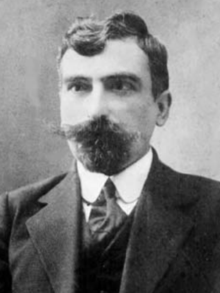Aram Manukian
Aram Manukian | |
|---|---|
 | |
| Governor of Western Armenia | |
| In office April 1915 – December 1917 | |
| Succeeded by | Tovmas Nazarbekian |
| Chairman of Karabagh | |
| In office November 1917 – November 15, 1918 | |
| Internal affairs minister of Armenia | |
| In office November 15, 1918 – December 13, 1918 | |
| Defense minister of Armenia | |
| In office November 15, 1918 – December 13, 1918 | |
| Personal details | |
| Born | 180px |
| Died | 180px |
| Resting place | 180px |
| Nationality | Armenian |
| Parent |
|
Aram Manukian or Aram Manoukian, Aram Manougian (Armenian: Արամ Մանուկեան, 1879 – 29 January 1919) also known as "Aram of Van" and to a lesser extent, "Sarkis (Serge) Hovanessian", was an Armenian revolutionary, politician and general who managed and led the Van Resistance and instrumented the founding of the Democratic Republic of Armenia. Manukian joined the Armenian Revolutionary Federation at a very early age. He is credited as a political, military and spiritual leader of the Armenian people during and after the Armenian Genocide.
Early years
Manukian was born in the village of Zeyva (modern-day David Bek) in the province of Elizavetpol, Russian Empire (modern-day Kapan region of Armenia). In 1903, he became involved in the defense of Gandzak and Kars, operations led by the ARF. In the autumn of 1904, he made his first visit to Van via Iran, where he promoted reform. In 1911, he travelled to Geneva where he spent a year before returning to Van, where he became the leader of the ARF in the region. In Van, he took an active role in the Armenian community by teaching at schools, communicating with the press, encouraging national establishments and promoting Armenian youth circles. He became a suspect in the murder of Bedros Kapamajian after a fellow Armenian accused him of the crime and was jailed by Ottoman officials. After attaining freedom, he travelled from Erzurum to Ordu as a teacher and activist organizer. With the beginning of World War I and the Armenian Genocide, he headed back to the city of Van. In 1915, he managed and led the successful Van Resistance against Ottoman authorities. With the Armenian victory, he was appointed as governor of Vaspurakan, which became a short-lived independent city.
National Council
After the reoccupation of Van by Ottoman troops, Manukian settled in Tbilisi, Georgia and occupied himself with the works of the ARF party bureau, the National Committee and the issues of the refugees of Van. By the end of 1917, he became the chief of the Armenian Congress of Eastern Armenians.
Democratic Republic of Armenia and death
In 1918, the National Committee sent Manukian to the Yerevan area as a fully authorized representative. There he helped found the Democratic Republic of Armenia and was appointed its First Interior Minister. He was also appointed as Minister of Labor and Defense Minister from November 15, 1918 to December 13, 1918. His took part in the organizing of the Battle of Sardarapat, which repulsed a Turkish attack on the newly established independent Armenia and stops the advance towards Yerevan.
In 1919, he fell ill and died at the age of 40 and was buried at the Tokhmakh Central Cemetery.
